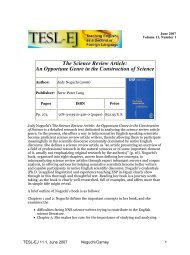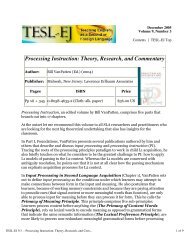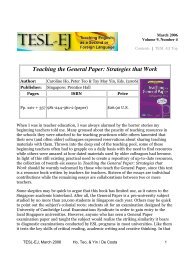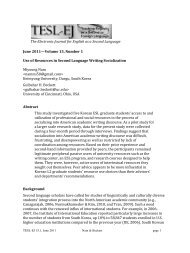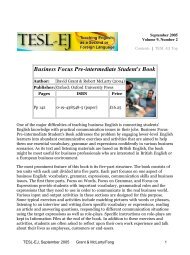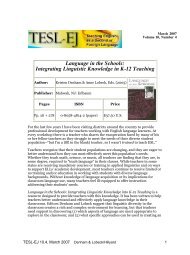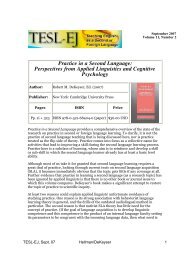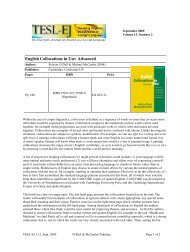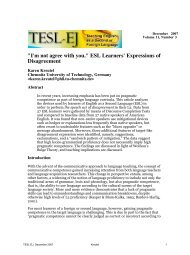TESL-EJ 10.4 -- Teaching English from a Global Perspective
TESL-EJ 10.4 -- Teaching English from a Global Perspective
TESL-EJ 10.4 -- Teaching English from a Global Perspective
You also want an ePaper? Increase the reach of your titles
YUMPU automatically turns print PDFs into web optimized ePapers that Google loves.
March 2007<br />
Volume 10, Number 4<br />
<strong>Teaching</strong> <strong>English</strong> <strong>from</strong> a <strong>Global</strong> <strong>Perspective</strong><br />
Author: Anne Burns, Ed. (2005)<br />
Publisher: Washington, DC: TESOL<br />
Pages ISBN Price<br />
Pp. viii +207<br />
193118518-2<br />
(paper)<br />
£ $24.95 for TESOL<br />
members;<br />
$32.95 for non-members<br />
A recent edition to the TESOL Practice Series, this volume addresses the implications<br />
of <strong>English</strong> as a global language for ESOL practitioners. Within a context of<br />
increasingly fluid linguistic, geographical and ideological boundaries, language<br />
teachers must be aware of and sensitive to the changing nature of language, teaching,<br />
learning, and language use. This volume presents examples <strong>from</strong> a variety of<br />
contexts and perspectives about how teachers are doing just that. Each of the eleven<br />
case studies is presented in similar format: introduction, description, distinguishing<br />
features, and practical ideas, with appendices that could be adapted for a variety of<br />
instructional contexts. The result is a collection that is, despite some minor<br />
weaknesses, extremely practical and reader friendly.<br />
In Chapter 1, Burns provides an articulate and succinct overview of the themes of the<br />
book, skillfully synthesizing relevant literature with the case studies into a framework<br />
that addresses six central questions related to the teaching of <strong>English</strong> as a global<br />
language:<br />
Part 1: Whose language?<br />
Part 2: Which speakers?<br />
Part 3: Which language?<br />
Part 4: Which standard?<br />
Part 5: Which approaches?<br />
Part 6: Which texts?<br />
Part 1 explores the poignant issue of <strong>English</strong> ownership. In Chapter 2, Brown<br />
describes the ways in which the MA TESOL program at Portland State University has<br />
aligned its curriculum with the university mission of internationalization by adopting<br />
<strong>TESL</strong>-<strong>EJ</strong> <strong>10.4</strong>, March 2007 Burns/Murphy 1
a World <strong>English</strong>es (WE) perspective. She asserts that teacher education programs<br />
must raise pre-service teachers' awareness about the changing ownership of <strong>English</strong><br />
to better prepare them for their future professional contexts. In Chapter 3, Friedrich<br />
describes a course for faculty in a Buenos Aires MBA program that was transitioning<br />
to <strong>English</strong> as the primary medium of instruction because of the growing international<br />
student body as well as institutional pressure on faculty to publish in <strong>English</strong>. Both<br />
chapters demonstrate how teacher education must view <strong>English</strong> as the domain not<br />
only of native speakers, but also of a variety of multi-competent users.<br />
Part 2 highlights the interrelatedness of language and culture. In Chapter 4, Meier<br />
describes a seminar offered in an MA-TESOL program at a US university that<br />
promoted awareness among pre-service teachers of culture's role in communication.<br />
Specifically, students reflected on the ways in which their own cultural backgrounds<br />
informed their perceptions of others. In Chapter 5, Matsuda investigates the<br />
mismatch between language policy and classroom practices in the context of<br />
Japanese high schools. The curricular goal of developing cultural and linguistic<br />
awareness through foreign language education is translated into the privileging of<br />
native <strong>English</strong> norms. These chapters suggest the importance of intercultural<br />
awareness in language education as well as the need to critically evaluate the ways in<br />
which curricula define and implement such awareness.<br />
Parts 3 and 4 focus on the struggles inherent in selecting appropriate varieties of<br />
<strong>English</strong> for the classroom. In Chapter 6, Evans describes a cross-cultural pragmatics<br />
course in a Sydney private language institute, which aimed to develop oral<br />
communicative competence in the workplace. Due to the multilingual backgrounds of<br />
the learners, Evans chose to integrate multiple language varieties into the classroom,<br />
using speakers within and outside the classroom as models. The choice to focus on<br />
the ways in which discourse practices may vary by cultural context helped learners<br />
develop greater facility in intercultural communication. In Chapter 7, Tarnopolsky<br />
discusses a business <strong>English</strong> course he taught in Ukraine and the challenges<br />
associated with his decision, based on learner needs, to use both British and<br />
American varieties. The chapter raises practical questions for those teachers<br />
planning to introduce multiple varieties of <strong>English</strong> in the absence of a distinct variety<br />
of <strong>English</strong> as a lingua franca. In Chapter 8, Brock reports on a survey distributed to<br />
pre-service and practicing <strong>English</strong> teachers in Macao soliciting their views on the<br />
importance of <strong>English</strong>, the government's role in <strong>English</strong> language teaching, and which<br />
'normative model' of <strong>English</strong> should be taught in secondary contexts. Responses<br />
indicated the need for increased opportunities for teachers' language development,<br />
guidelines on language standards, use of regional <strong>English</strong> varieties, and proactive<br />
teacher participation in advocating language policies. This article provides a useful<br />
example of the ways in which teacher attitudes have direct implications for both<br />
practice and policy. Together, these chapters underline how important it is to select<br />
appropriate <strong>English</strong> varieties for instruction, varieties based on learner goals and<br />
contexts of language use.<br />
Part 5 is disappointingly spare, with only one case study, a study describing the<br />
Philippines <strong>English</strong> Language <strong>Teaching</strong> (PELT) Project: a teacher education project<br />
which aimed to promote communicative language teaching (CLT) in response to a<br />
perceived decline in the quality of <strong>English</strong> use in public schools. However, the absence<br />
of a clear rationale to implement CLT begs the question of what is meant by CLT and<br />
who, teachers or administrators, deem it appropriate to use across diverse<br />
<strong>TESL</strong>-<strong>EJ</strong> <strong>10.4</strong>, March 2007 Burns/Murphy 2
classroom contexts. It would have been helpful to learn more about whose language<br />
use was deteriorating and how (e.g., measures of proficiency, test scores, etc.), in<br />
order to better understand why CLT was deemed an appropriate response and to<br />
what degree such an approach departed <strong>from</strong> existing practices. Nevertheless, the<br />
article highlights the importance of providing ongoing teacher education to<br />
successfully implement educational reform.<br />
Part 6 is one of the stronger sections of the book, both for its case study diversity and<br />
the innovative ways in which the teacher-writers use learner needs and local contexts<br />
to inform pedagogical practices. Chapter 10 describes how a post-graduate course in<br />
literacy education underwent a sociocultural shift to respond to the dynamic,<br />
multimodal literacy practices ushered in by the forces of globalization. Chapters 11<br />
and 12 each discusses a university course for international students which exploits<br />
globalization as course content to promote language, critical thinking, and student<br />
engagement. In Chapter 11, Bozzini introduces students at George Washington<br />
University (District of Columbia) to the literature of global <strong>English</strong> in order "to<br />
create a common intellectual locus for peoples of the world" (p. 155). Similarly,<br />
Cooke, teaching at York University in Ontario, explores the impacts of globalization<br />
as a means of developing learner knowledge of argument text structure within<br />
current public discourses.<br />
The themes raised in this collection call to mind Hornberger's (2003) assertion that<br />
"[t]he challenge of negotiating across multiple languages, cultures, and identities is a<br />
very real one in classrooms all over the world, one not to be lightly dismissed. Yet, on<br />
the whole, educational policy and practice continues blithely to disregard the presence<br />
of multiple languages, cultures, and identities in today's classrooms" (p. 330). This<br />
volume attempts to address a very real need for the ELT profession to counteract<br />
this criticism. Together, the chapters call for a reorientation, away <strong>from</strong> native<br />
norms to more multilingual perspectives and closer attention to local contexts to<br />
inform pedagogical approaches. However, Burns acknowledges that while her<br />
contributors', and others', efforts are a valuable step toward addressing the issues,<br />
much more work needs to be done: "Clearly, despite some of the theoretical debates<br />
of the past 10-15 years, classroom practitioners are still in a transitional and<br />
tentative phase of experimentation in coming to grips with the implications of<br />
teaching <strong>English</strong> as a global language" (p. 15).<br />
To my mind, one of the most noticeable gaps is the voice of the learners themselves.<br />
While central to educational research, investigations of teacher education and<br />
attitudes tell us little about their relationship to student learning or actual classroom<br />
practices. Perhaps this book tells us as much about what needs to happen as it does<br />
about how practitioners are currently responding to the complex issues arising <strong>from</strong><br />
ELT in global and local contexts.<br />
References<br />
Hornberger, N H. (Ed). (2003). Continua of biliteracy: An ecological framework for<br />
educational policy, research and practice in multilingual settings. Clevedon:<br />
Multilingual Matters. Retrieved November 17, 2006, <strong>from</strong><br />
http://site.ebrary.com/lib/nau/Doc?id=10051991&ppg=360<br />
Erin-Kate Murphy<br />
<strong>TESL</strong>-<strong>EJ</strong> <strong>10.4</strong>, March 2007 Burns/Murphy 3
Northern Arizona University<br />
<br />
© Copyright rests with authors. Please cite <strong>TESL</strong>-<strong>EJ</strong> appropriately.<br />
<strong>TESL</strong>-<strong>EJ</strong> <strong>10.4</strong>, March 2007 Burns/Murphy 4



